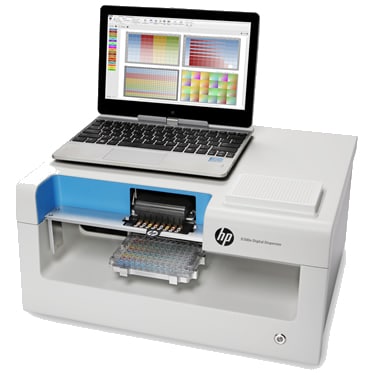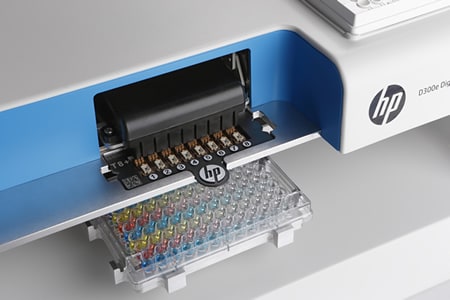Pilot Program with HP Accelerates Antibiotic Testing
Posted On: September 2018
- Through CDC’s Antibiotic Resistance (AR) Solutions Initiative, the agency is transforming the nation’s capacity to further detect, respond, and prevent antibiotic-resistant threats across healthcare settings and in communities to protect Americans and save lives.
- To help better detect resistance and treat patients, CDC and HP Inc. launched a pilot program in 2018, installing specialized inkjet printers in four AR Lab Network regional labs.
- The printers allow for on-demand testing that tells healthcare providers if specific antibiotics will work to treat an infection, or if the germ is resistant to the new antibiotic.
In 2018, CDC and HP Inc. launched a pilot program, installing HP printers as part of CDC’s Antibiotic Resistance Laboratory Network (AR Lab Network). The inkjet printing technology, adapted for printing antibiotic susceptibility testing (AST) panels, will help clinicians decide if a new-to-market drug could effectively treat a highly drug-resistant infection.
HP Printers Test for Antibiotic Resistance
The modified printer technology “prints” drugs rather than ink. With this technology, labs can test drugs that are new to the market to determine whether they will be effective against an infection.
Any time antibiotics are used, they can cause side effects and lead to antibiotic resistance. New antibiotics can save lives when used to treat infections caused by the most resistant bacteria, but doctors need to use specialized testing methods to know if the new drugs will work. There is often a gap between the approval of a new drug and the availability of testing methods for this new drug in hospital laboratories. When susceptibility testing is not available, healthcare providers are not able to determine the most effective antibiotic for their patients. This means patients might not receive the right antibiotics to treat their infection, which can lead to unnecessary side effects or prolonged treatment, and contributes to antibiotic resistance.
By printing susceptibility panels on demand, we can now perform susceptibility testing on new drugs, before commercial methods are available. This helps make sure the newest drugs last longer, and puts gold-standard lab results into the hands of healthcare providers faster.
Testing at CDC will start in fall 2018, and will be implemented in four AR Lab Network regional labs (Tennessee State Public Health Laboratory, Wisconsin State Laboratory of Hygiene, Minnesota Department of Health Public Health Laboratory, and Wadsworth Center Laboratories) in early 2019.
The Science of Printing Technology
CDC is using HP’s inkjet-like printing technology to dispense drugs for testing and ultimately improve use of new-to-market antibiotics. The printers help laboratorians improve testing efficiency and accuracy. To use the printers, laboratorians place the new drug solution in the printer, like adding ink to an ink cartridge. Then they prepare a 96-well plate. These plates provide up to 96 small test tubes that hold samples of the germs causing a patient’s infection. Using a software program, the lab decides which drugs are placed in each well and at which concentration. Multiple drugs can be tested at once. This is called a microdilution minimum inhibitory concentration (MIC) panel. If the germs are able to grow in the wells after the drugs are placed, then the germ may be resistant to that concentration of the drug solution. These results are then reported back to the healthcare provider, helping them to know what drugs to prescribe and at what dose.
The labs will prioritize testing for highly resistant bacteria, with pan-resistant bacteria being the top priority. Following the year-long pilot, the project will be evaluated, refined, and assessed for a potential larger rollout of the technology in nationally.
CDC Fights Antibiotic Resistance
This pilot program is part of CDC’s larger efforts to tackle the threat of antibiotic resistance by driving aggressive action with healthcare, veterinary, and agriculture partners, and empowering the nation to comprehensively respond to antibiotic resistance. As part of this investment, known as the AR Solutions Initiative, CDC established and supports comprehensive lab capacity across the nation.
The AR Lab Network supports nationwide lab capacity to rapidly detect antibiotic resistance in healthcare, food, and the community, and inform local responses to prevent spread and protect people. As a result of this enhanced capacity, the public health community is better able to rapidly detect emerging AR threats, sound the alarm for a comprehensive local response, and better understand these deadly threats so we can contain them quickly.
The AR Lab Network was established in 2016, and includes labs in 50 states, five cities, and Puerto Rico, including seven regional labs and the National Tuberculosis Molecular Surveillance Center (National TB Center). In its first two years, the AR Lab Network uncovered unusual resistance 221 times in “nightmare bacteria” and helped launch early, aggressive responses to contain spread and protect people. In 2018, with nationwide testing well underway, CDC is collaborating with experts to ensure the best tools and technology are in public health departments.

